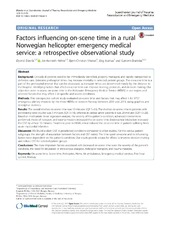| dc.contributor.author | Østerås, Øyvind | en_US |
| dc.contributor.author | Heltne, Jon-Kenneth | en_US |
| dc.contributor.author | Vikenes, Bjarne H | en_US |
| dc.contributor.author | Assmus, Jörg | en_US |
| dc.contributor.author | Brattebø, Guttorm | en_US |
| dc.date.accessioned | 2018-08-10T12:43:42Z | |
| dc.date.available | 2018-08-10T12:43:42Z | |
| dc.date.issued | 2017-09-21 | |
| dc.Published | Østerås ØØ, Heltne JK, Vikenes BH, Assmus J, Brattebø G. Factors influencing on-scene time in a rural Norwegian helicopter emergency medical service: A retrospective observational study. Scandinavian Journal of Trauma, Resuscitation and Emergency Medicine. 2017;25:97 | eng |
| dc.identifier.issn | 1757-7241 | |
| dc.identifier.uri | https://hdl.handle.net/1956/18038 | |
| dc.description.abstract | Background: Critically ill patients need to be immediately identified, properly managed, and rapidly transported to definitive care. Extensive prehospital times may increase mortality in selected patient groups. The on-scene time is a part of the prehospital interval that can be decreased, as transport times are determined mostly by the distance to the hospital. Identifying factors that affect on-scene time can improve training, protocols, and decision making. Our objectives were to assess on-scene time in the Helicopter Emergency Medical Service (HEMS) in our region and selected factors that may affect it in specific and severe conditions. Methods: This retrospective cohort study evaluated on-scene time and factors that may affect it for 9757 emergency primary missions by the three HEMSs in western Norway between 2009 and 2013, using graphics and descriptive statistics. Results: The overall median on-scene time was 10 minutes (IQR 5–16). The median on-scene time in patients with penetrating torso injuries was 5 minutes (IQR 3–10), whereas in cardiac arrest patients it was 20 minutes (IQR 13–28). Based on multivariate linear regression analysis, the severity of the patient’s condition, advanced interventions performed, mode of transport, and trauma missions increased the on-scene time. Endotracheal intubation increased the OST by almost 10 minutes. Treatment prior to HEMS arrival reduced the on-scene time in patients suffering from acute myocardial infarction. Discussion: We found a short OST in preselected conditions compared to other studies. For the various patient subgroups, the strength of association between factors and OST varied. The time spent on-scene and its influencing factors were dependent on the patient’s condition. Our results provide a basis for efforts to improve decision making and reduce OST for selected patient groups. Conclusions: The most important factors associated with increased on-scene time were the severity of the patient’s condition, the need for intubation or intravenous analgesic, helicopter transport, and trauma missions. | en_US |
| dc.language.iso | eng | eng |
| dc.publisher | BioMed Central | eng |
| dc.rights | Attribution CC BY | eng |
| dc.rights.uri | http://creativecommons.org/licenses/by/4.0 | eng |
| dc.subject | On-scene time | eng |
| dc.subject | Scene time | eng |
| dc.subject | Helicopter | eng |
| dc.subject | Hems | eng |
| dc.subject | Air ambulances | eng |
| dc.subject | Emergency medical services | eng |
| dc.subject | First hour quintet | eng |
| dc.subject | Norway | eng |
| dc.title | Factors influencing on-scene time in a rural Norwegian helicopter emergency medical service: A retrospective observational study | en_US |
| dc.type | Peer reviewed | |
| dc.type | Journal article | |
| dc.date.updated | 2018-03-06T13:36:41Z | |
| dc.description.version | publishedVersion | en_US |
| dc.rights.holder | Copyright 2017 The Author(s) | |
| dc.identifier.doi | https://doi.org/10.1186/s13049-017-0442-5 | |
| dc.identifier.cristin | 1511536 | |
| dc.source.journal | Scandinavian Journal of Trauma, Resuscitation and Emergency Medicine | |

